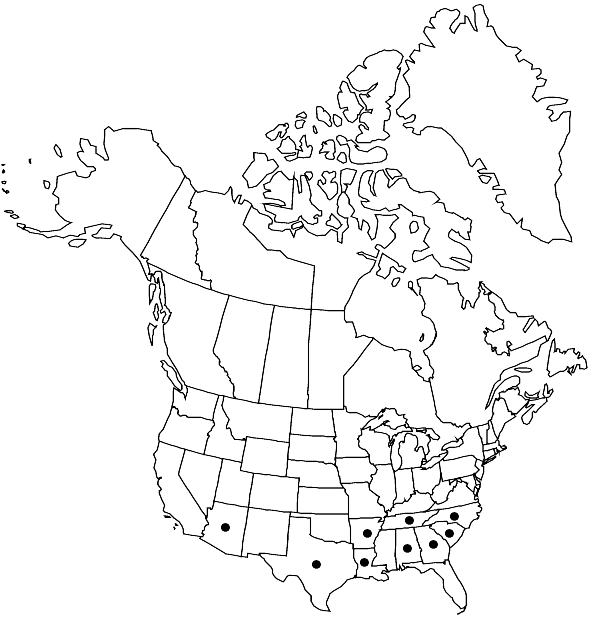Difference between revisions of "Campylopus pilifer"
Muscol. Recent., suppl. 4: 72. 1818,.
FNA>Volume Importer |
imported>Volume Importer |
||
| (6 intermediate revisions by 2 users not shown) | |||
| Line 10: | Line 10: | ||
|name=Campylopus leucotrichus | |name=Campylopus leucotrichus | ||
|authority=Sullivant & Lesquereux | |authority=Sullivant & Lesquereux | ||
| + | |rank=species | ||
}} | }} | ||
|hierarchy=Dicranaceae;Campylopus;Campylopus pilifer | |hierarchy=Dicranaceae;Campylopus;Campylopus pilifer | ||
| Line 24: | Line 25: | ||
|elevation=50-1500 m | |elevation=50-1500 m | ||
|distribution=Ala.;Ariz.;Ark.;Ga.;La.;N.C.;S.C.;Tenn.;Tex.;Central America;South America;s;w Europe;Asia (Sri Lanka);c Africa. | |distribution=Ala.;Ariz.;Ark.;Ga.;La.;N.C.;S.C.;Tenn.;Tex.;Central America;South America;s;w Europe;Asia (Sri Lanka);c Africa. | ||
| − | |discussion=<p>The distribution of Campylopus pilifer in tropical America, tropical Africa, and Sri Lanka (but not other parts of Asia) suggests a Gondwanaland origin, from where the species has extended its range into warmer parts of North America and southwestern Europe. Until 30 years ago this species was not distinguished from C. introflexus, and accordingly all old references from North America must be referred to C. pilifer. The true C. introflexus has been a neophyte in North America since 1975.</p> | + | |discussion=<p>The distribution of <i>Campylopus pilifer</i> in tropical America, tropical Africa, and Sri Lanka (but not other parts of Asia) suggests a Gondwanaland origin, from where the species has extended its range into warmer parts of North America and southwestern Europe. Until 30 years ago this species was not distinguished from <i>C. introflexus</i>, and accordingly all old references from North America must be referred to <i>C. pilifer</i>. The true <i>C. introflexus</i> has been a neophyte in North America since 1975.</p> |
|tables= | |tables= | ||
|references= | |references= | ||
| Line 33: | Line 34: | ||
-->{{#Taxon: | -->{{#Taxon: | ||
name=Campylopus pilifer | name=Campylopus pilifer | ||
| − | |||
|authority=Bridel | |authority=Bridel | ||
|rank=species | |rank=species | ||
| Line 47: | Line 47: | ||
|publication year= | |publication year= | ||
|special status= | |special status= | ||
| − | |source xml=https:// | + | |source xml=https://bitbucket.org/aafc-mbb/fna-data-curation/src/2e0870ddd59836b60bcf96646a41e87ea5a5943a/coarse_grained_fna_xml/V27/V27_526.xml |
|genus=Campylopus | |genus=Campylopus | ||
|species=Campylopus pilifer | |species=Campylopus pilifer | ||
Latest revision as of 21:26, 5 November 2020
Plants 0.5–3 cm long, in tufts, dirty green, olive green, or yellowish green, darker below, equally foliate, the fertile ones comose. Leaves 4–7 mm, erect spreading or loosely appressed, lanceolate, ending in a straight, more or less long serrate hairpoint; alar cells not differentiated or strongly developed, inflated, thin-walled, hyaline or reddish; basal laminal cells hyaline, thin-walled, rectangular, forming a V-shaped area; distal laminal cells oval to rhomboidal, ca. 2:1; costa filling 1/2–3/4 of leaf width, excurrent in a hairpoint, in transverse section showing adaxial hyalocysts and abaxial groups of stereids, abaxially with lamellae 3–4 cells high. Specialized asexual reproduction occasionally by deciduous stem tips. Seta often aggregated, about 5 mm, sinuose. Capsule 1.5 mm, slightly asymmetric, furrowed when dry, brownish; operculum rostrate. Calyptra fringed at base. Spores ca. 13 µm.
Habitat: Acidic sandy soil and acidic rocks (sandstone, granite), rock crevices, exposed, dry habitats
Elevation: 50-1500 m
Distribution

Ala., Ariz., Ark., Ga., La., N.C., S.C., Tenn., Tex., Central America, South America, s, w Europe, Asia (Sri Lanka), c Africa.
Discussion
The distribution of Campylopus pilifer in tropical America, tropical Africa, and Sri Lanka (but not other parts of Asia) suggests a Gondwanaland origin, from where the species has extended its range into warmer parts of North America and southwestern Europe. Until 30 years ago this species was not distinguished from C. introflexus, and accordingly all old references from North America must be referred to C. pilifer. The true C. introflexus has been a neophyte in North America since 1975.
Selected References
None.